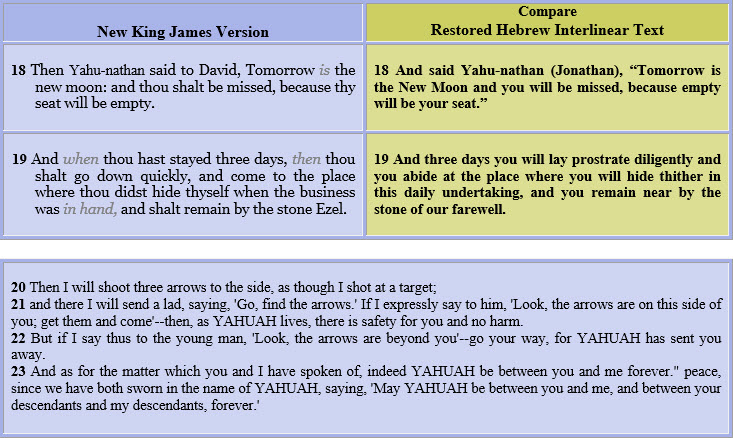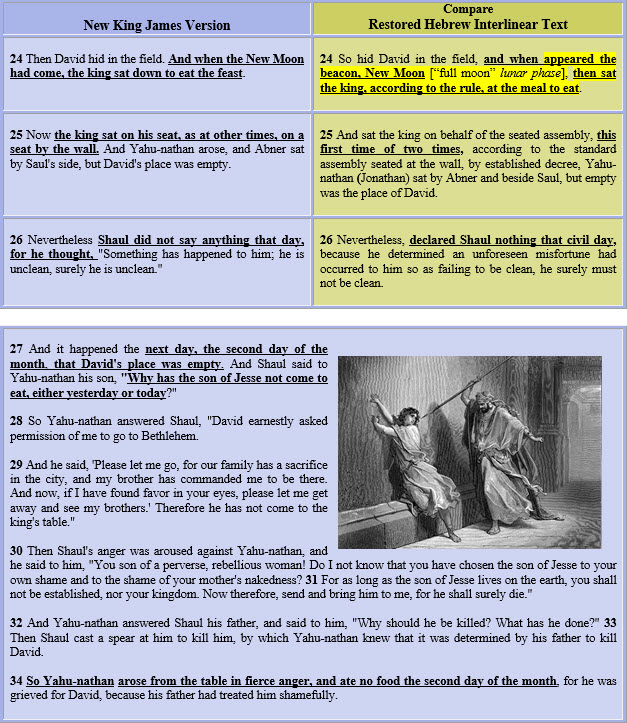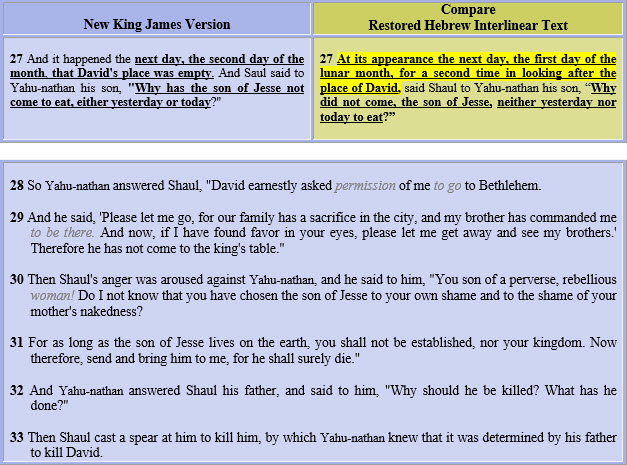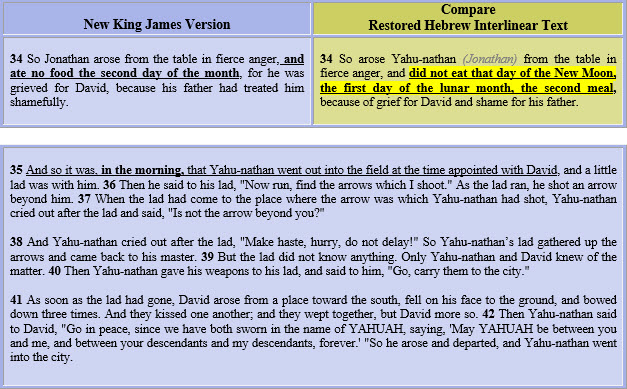Tomorrow is the New Moon! 1 Samuel 20
Tomorrow is the New Moon!
Evidence for a Single New Moon Day Event
New Light on 1 Samuel 20

1 Shemu’el (Samuel) 20:1-42
[T]he subject matter presented in this Scripture narrative and word study of 1 Shemu’el (Samuel) 20:1-42 carries inordinate weight and significance among many lunar Sabbatarians. With much prayer and research, it is determined that “new light” has come forth from the rubble of translation errors and calendar changes occurring among the Romans and the Yahudim (Jews) over the last 2,000 years. It is our steadfast belief that we continue to have much to learn and an equal amount to unlearn.
Placing each word in the restored interlinear order of the original Hebrew text reveals that there is only a reference to a “second commemorative banquet meal” and not to a “second New Moon Day.” Add to this that when all the evidence is in, both references to “Tomorrow is the New Moon Day” refer to the full New Moon lunar phase, appearing in tomorrow’s night sky, with the following day, from sunrise to sunset, being the actual “New Moon Day.” Both commemorative banquet meals were eaten on two separate yet successive nights only after the conspicuous appearance of the full New Moon arose after sunset and shone from the east unto the west all night long.
The first commemorative banquet meal was served on the night the full moon rose at sunset and made its way along the east-west time continuum, announcing the New Moon Day to begin the following morning at sunrise. And the second commemorative banquet meal was served at its conclusion. This occurred the night following the entire 12-hour New Moon Day, which ended at sunset. These two commemorative banquet meals behaved as bookends or boundaries on either end of the authentic first day of the lunar month, the full New Moon Day.
This interlinear Hebrew word study presentation will utilize the New King James Version verse-by-verse comparison with Strong’s Hebrew word numbering system. It will harmonize the Strong’s numbering system with the original Hebrew terms and their prefixes and suffixes. Each verse in question will begin with a side-by-side comparison in the word study chart, displaying the differences between the English KJV and the Restored Hebrew Interlinear Text. The Strong’s Bible Dictionary and Brown-Driver-Brigg’s Hebrew Lexicon present the best possible Hebrew word intent in a concise and straightforward format. This interlinear Hebrew word study places each word in its corrected order of the original Hebrew text, and this alone has had an enormous impact on this study. Bible translators often change the order of words to make linguistic sense. However, on occasion, they have proactively taken licenses and have been the cause of Scriptural error. This appears to be the case here in 1 Shemu’el (Samuel) 20:1-42.
Questions to be answered in this word study:
- Is the first mention of the New Moon referring to New Moon Day or the New Moon lunar phase in the night sky?
- Does the Hebrew text support a belief that the New Moon is a dark lunar phase or does the text sustain a visible manifestation as the true full New Moon lunar phase?
- Does the Hebrew text propose a double New Moon Day, or is this verse referring to two commemorative meals that act as bookends for a single New Moon Day?
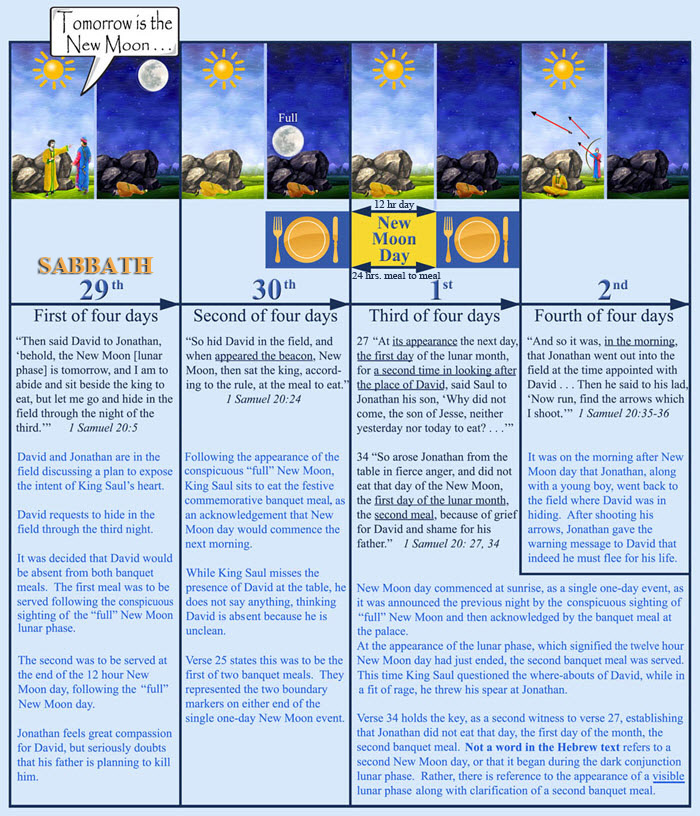
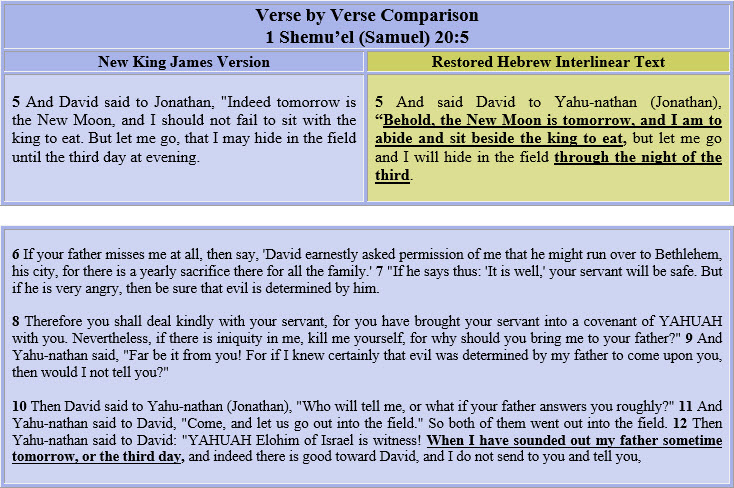
In the Scripture narrative above, the scene opens on either the 28th day of a 29-day month or the 29th day of a 30-day month. Either way, the same results are achieved. For illustration purposes, this study will utilize the 29th day, a Sabbath, as day one of this four-day sequence of days. David recently fled from King Shaul (Saul), who had followed him to Naioth, but now he is seeking solace from his beloved friend air jordan 6 toro Yahu-Nathan (Jonathan).
Verse 5 opens with David declaring to Yahu-Nathan (Jonathan), “Tomorrow is the New Moon!” From this short statement of fact, we can deduce two things: 1) The term “tomorrow” refers to a single-day event that will begin the next day at sunrise. 2) The “New Moon” is to occur “tomorrow,” synchronizing two things – New Moon Day with tomorrow, a single lunation event. The real answer is provided in this first statement, but there are more facts to be revealed in this Torah chapter that are worth pursuing.
A nearly full moon, marked by its position 10-12 degrees above the eastern horizon, was visible in the night sky that evening after sunset. (As a reminder, each lunar phase can be identified by its position in the shamayim (heavens) and the light it receives from the sun.) This is why, in verse 5, David could say to Yahu-Nathan, “Behold, the New Moon is tomorrow,” referring to the nearly full moon” lunar phase 10-12 degrees above the horizon. Might David have reasoned the full moon as the New Moon must be seen rise tomorrow because the lunar phase was nearly full and positioned above the horizon at sunset today? The mounting weight of evidence will demonstrate that David was not referring directly to the New Moon “day” but to the coming “full moon” lunar phase, which announces the New Moon Day.
Some have declared that this day could not be a Sabbath because David and Yahu-Nathan would not have been able to leave their dwellings on the Sabbath according to the rule of Exodus 16:29. It states, “Let every man remain in his place; let no man go out of his place on the seventh day.” However, this command was specifically given for gathering manna on the morning of the Sabbath. No one was to go out to gather manna on Sabbath morning because a double portion had already been given on the sixth day. But this statement only applied to gathering manna in the early morning of the Sabbath as this is when manna was present on other days. The statement “not to go out of their place” could not refer to all day and was not a Sabbath principle. Rather, seventh-day Sabbaths, in addition to all the other festivals, were holy appointed assemblies for corporate worship. Faithful Israelites indeed left their homes to assemble for prayer and praise at the Tabernacle/Temple courtyard (when it was present) and for the reading of the Torah.
Years later, the Messiah was accused of breaking the Sabbath as He walked with His disciples through a cornfield on the Sabbath. A truth that trumps all others is that David fled and feared for his very life. This story resembles a donkey in a ditch. When someone is in dire need and in a life-threatening situation, it is never wrong to help, whether it is a Sabbath or not. There is no sign here in this narrative of work being done.
Verse 5 is the first verse in question, and above is the comparison. While this verse explicitly states, “Behold, the New Moon is tomorrow,” the Hebrew text does not define it with the term “DAY.” Verses 5 and 18 will be compared later with verses 27 and 34, which describe the second commemorative banquet meal as having occurred on the actual New Moon “Day,” the following day beginning at sunrise, the third day in the sequence. Therefore, David’s mention of “tomorrow” is about the 30th civil calendar date, or at the least, the last day of the lunar month, when the conspicuous “full” New Moon would appear at sunset.
Chodesh #2320 refers to the New Moon lunar phase or lunar month as a whole, which has a beginning and an ending. The context of the sentence reveals whether it is the lunar phase itself or the actual New Moon Day. For example, Ezekiel 46:1 states, on the Sabbath, the east gate shall be opened and on the DAY of the New Moon.”
The end of Verse 5 identifies a period of three days upon which the following events are to occur, as it states, “through the night of the third.” Yet, in verse 35, it is the morning of the 4th day when Yahu-Nathan revealed the results to David of the genuine intentions King Shaul (Saul) had to kill him.
Both views commence on day one, as illustrated in the chart above, the day David says to Yahu-Nathan, “Behold, the New Moon is tomorrow.” Both views usurp that “tomorrow” represents the lunar month’s last day, either the 29th or the 30th day. If it is the 29th day, it is the last Sabbath of the lunar month. Either way, “tomorrow” is followed by the actual New Moon Day (1st Day). This is then followed by the 2nd day of the lunar month. There is never a time in counting that the last day of any month is followed by the 1st day, and then again followed by another 1st day of the month. Yet, this appears to be what some believe, who declare there to be two “New Moon Days.”
The New Moon lunar phase is a single and specific, one-time lunar event each month, which means its time interval incorporates a single earth rotation and never two.
Confirmation of Three Days
Here, verse 12 confirms a sequence of three days, and we know from verse 35 that Yahu-Nathan revealed the results to David on the morning of the 4th day.
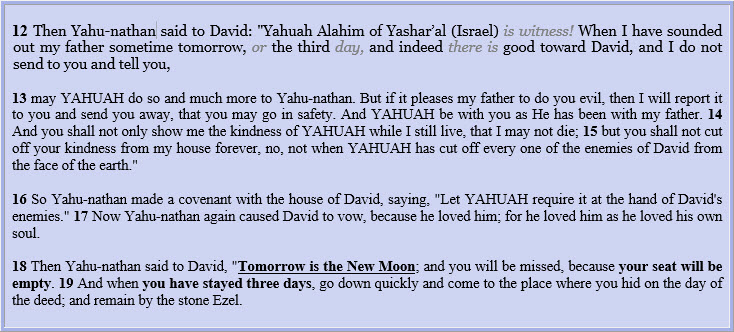 In verse 18, Yahu-Nathan repeats David’s statement, but in different words, “Tomorrow is the New Moon.” “You will be missed because your seat will be empty.” So Yahu-Nathan arranged a plan whereby David would be absent from his pre-appointed place at the table for the celebration night that the “full” New Moon was witnessed in Israel. This was when the shofar was sounded in Israel, and the fires were set ablaze upon the highest hills. The signals announced that the New Moon day was to commence the following morning at sunrise.
In verse 18, Yahu-Nathan repeats David’s statement, but in different words, “Tomorrow is the New Moon.” “You will be missed because your seat will be empty.” So Yahu-Nathan arranged a plan whereby David would be absent from his pre-appointed place at the table for the celebration night that the “full” New Moon was witnessed in Israel. This was when the shofar was sounded in Israel, and the fires were set ablaze upon the highest hills. The signals announced that the New Moon day was to commence the following morning at sunrise.
In verse 19, it appears Yahu-Nathan councils David to lay prostrate for three days, perhaps in continual prayer before Yahuah, the remainder of today, tomorrow, and the third day.
Beginning with verse 24, it is discovered that it was only after the physical appearance of the full New Moon that the king sat down at the meal to eat. It seems reasonable that the criteria upon which the meal was to be eaten relied entirely upon the appearance of the full New Moon.
Scripture’s weight of evidence requires the correct New Moon to incorporate all the following attributes more comprehensively:
- Rule all night from east to west . . . Genesis 1:16, Psalms 136:9, Jeremiah 31:35 (see word study)
- Make manifest by the “light” . . . . . . . . Ephesians 5:13, Genesis 1:14-15 (see word study)
- It must be “visibly conspicuous”. . . . . Psalms 89:37, Revelation 12:1 (see word study)
- It must be a “waxed” lunar phase . . . . Proverbs 4:18-19 (see word study)
- It must be “new” or “renewed” . . . . . . Isaiah 66:23, Ezekiel 46:1 (See Word Study)
- It must be a single “one day event” . . . Isaiah 66:23 (see word study)
As a result of this evidence in verse 24, is it likely that this first commemorative banquet meal occurred at any other time of day other than immediately following sunset on the 30th of the lunar month? It appears that the second commemorative banquet meal was also scheduled to be at night, following the twelve-hour day of the full New Moon. This is supported by the fact that David requested to be absent through the night of the third day, as stated in verse 5.
In verse 25, some Hebrew details appear to be made into generalized statements in the KJV, but not enough to affect the timing of the New Moons or the meals. Here, it is clarified that the king sat for the first of two preordained banquet meals.
Verse 26 reveals that King Shaul (Saul) clearly missed David at the first commemorative banquet meal but said nothing because he thought David must have been unclean. When someone is unclean, they are unclean until evening and would not be ready to attend a sacred event. As King Shaul did not know David’s whereabouts, he may have believed he was not near enough to arrive on time for the banquet meal.
The New Moon day is completed at the appearance of this next lunar phase. Only then, for a second time, King Shaul, sitting at the commemorative banquet meal, looks after the place of David. He finally asks Yahu-Nathan (Jonathan) why David didn’t come yesterday or today to eat. Like bookends, the two commemorative banquet meals were designed to be eaten as two boundary markers or parameters for a single New Moon Day event. These two meals corresponded to the night of the “full moon” and the next night after the New Moon Day. Sunset is the determining factor that the New Moon Day, as well as all days, has fully ended.
Nowhere in the Hebrew interlinear text of verse 27 is this “next day” referred to as the second day of the month. Rather, it is called the “New Moon Day,” the first day of the lunar month. The only reference to the word “second” is in relation to a second meal in which David is absent. This verse does not support the belief that there is ever a two-day New Moon.
Verse 34, as a second witness, nails down that verse 27 is indeed referring to a second commemorative banquet meal and not to a second day of the month or second New Moon day. Yahu-Nathan (Jonathan) could not eat the second commemorative meal on that “New Moon day,” the first day of the lunar month, because of grief for David and shame for his father.
Astonishingly, there is NO reference in verse 27 or verse 34 of the Restored Hebrew Interlinear Text regarding a “second “first” day of the month” or, more specifically, a “second New Moon Day.”
Both verses 27 and 34 defined that the second meal occurred after the New Moon Day, not the night of the conspicuous full New Moon lunar phase.
Below are three historical quotes: The first two illustrate that the New Moon day, from sunrise to sunset, was a day of fasting and prayer. But as has been illustrated in this article, the third quote defines ir jordan 3 whataburger custom state banquets on New Moon occasions. These two views can be synchronized only if the banquet meals occurred at sunset on either side of the New Moon Day as bookends for this landmark occasion.
“Each New Moon was celebrated with a fast.” Jewish Family Celebrations, p. 35.
“. . . The sacred festival of the new moon, which people give notice of with trumpets, and the day of fasting, on which abstinence from all meats and drinks is enjoined . . .” Philo Book 26, p. 159
“The first day of the lunar month was observed as a holy day. . . As on the Sabbath, trade and handicraft work were stopped (Amos 8:5; Ezekiel 46:3) and the temple [east gate] was opened for public worship…. It was an occasion for state banquets (1 Sam. 20:5-24).” Smith’s Bible Dictionary (1884): “New Moon.”
So, where did the two-day New Moon tradition come from?
“…Rabbis in the academies of Babylonia declared that because of uncertainty of the calendar, Rosh Hashana should be celebrated as a two-day holiday… Since the Bible specified that Rosh Hashana should be a one-day holiday [Exodus 12:1-3 as it relates to Rosh Hashanah and the 14 day count to Passover], the Rabbis had to justify the change of a two-day holiday. This was done by means of a legal-fiction: they began referring to the two days of Rosh Hashana as “Yoma Arichta,” meaning “one long day of forty-eight hours”…Tishri is a Babylonian word and WAS NOT used to designate the seventh month in the Jewish calendar until after the Babylonian exile, when the Jews returned to Palestine 50 — цена 600 грн в каталоге Ветровки ✓ Купить мужские вещи по доступной цене на Шафе , Ветровка nike air р 48 - Украина #66611078 - nike roshe run nm fb grey camo pants boys blue. The name Tishri is never mentioned in the Bible. This is the Torah, p. 315, 386.
- Note in the quote above, it refers to the Rabbis in the academies of Babylon, who were not seeking faithfulness to Yahuah, the Most High.
- They ignored Scriptures and justified a two-day Rosh Hashanah (New Year’s Day).
- The Rabbi’s created an altogether new teaching “Yom Archta,” meaning one long day of forty-eight hours.
- They moved Rosh Hashanah (New Year’s Day) to “Tishri,” Babylon’s first month, which corresponds to the Scripture’s seventh month.
- This is just one evidence of the level of which the Rabbinical Pharisees have rearranged time after rising to power in the wake of the destruction of the temple in A.D. 70.
Summary
- Day one of this four-day sequence can be either the 28th day of a 29-day lunar month or the 29th day of a 30-day lunar month. In either case, the results are the same, as it is unknown whether this was a 29 or 30-day month. It is primarily the modern Rabbinical Pharisee Jews and those who synchronize to them, keeping a dark conjunction lunar phase as the New Moon, who believe that when two dark lunar phases occur two days in a row, this is a sign of a two-day New Moon. However, the evidence in this article suggests otherwise for a multitude of reasons.
- “Behold, the New Moon is tomorrow,” testifies that a full New Moon lunar phase was to be visibly witnessed the next evening near sunset on the 30th of the month. This night of the full moon announces that the New Moon Day and a new month will commence the following morning at sunrise. This is demonstrated by comparing the context of verses 5 and 18 with the context of verses 27 and 34. The context bears out that David was declaring “tomorrow” to be the appearance of the conspicuous full moon lunar phase, which is supported in verse 24, which states, “when the New Moon appeared [a visual event], then the King sat down to eat.”
- The appearance of the full moon lunar phase was the signal that announced a new month was to begin the next morning, and for this reason, the banquet was served. The term “Tomorrow” referred to “day two” of the four-day sequence of events, yet it was synchronized solely to the first day of the lunar month. It is no easier to have two New Moon Days than it is to have two tomorrows. There is only one tomorrow, which aligns with a single-day event that follows today and tonight.
- David lays prostrate for the duration of three days in the field in continual prayer before Yahuah. He was to receive news from Jonathan on the morning of the fourth day, according to verse 35.
- Following the appearance of the full New Moon, the king sat at the first commemorative banquet meal to eat. While David was missed, the king did not say anything. This banquet meal, together with the full moon, announced that the New Moon Day would begin the following morning. It was the completion of the second day of the four-day sequence of events.
- Since both the Sabbath and New Moon days are Kadosh (sacred) days, according to Ezekiel 46:3, King Shaul’s servants would not have been preparing food nor orchestrating the two commemorative banquet meals during the sacred 12-hours of either the Sabbath daylight or the New Moon daylight. Therefore, if the month ended on the 29th day (always the Sabbath) of the lunar month, the first commemorative banquet meal was served after sunset. If, on the other hand, the month ended on the 30th day (never a Sabbath), food preparations could have been made any time throughout the day. The second commemorative meal was served after sunset following the New Moon day. In this way, the single New Moon day was at all times sandwiched between two commemorative banquet meals. This story shows no record of David or King Shaul feasting or eating during the sacred portion of this New Moon day, the 12 hours from sunrise to sunset. Refer to the article – Worship at the East Gate.
- In verse 27, the Hebrew interlinear text refers to the “next day” as the actual New Moon Day because the text clarifies it as the “next day” followed by the term (Chodesh #2320) New Moon Day or lunar month. This was the third day of the four-day sequence.
- Both verses 27 and 34 clarify the second commemorative banquet meal was served after sunset following the completion of the New Moon day. This was the third day of the four-day sequence.
- There is absolutely no reference in verse 27 or verse 34 in the Hebrew interlinear text regarding a “second day of the month” or, more specifically, a “second New Moon day.” Instead, it is demonstrated that the English translation has placed several words out of their original order, thus creating a misunderstanding. The text refers only to a second meal following the New Moon day and not a second meal on a second New Moon day.
- There is no mention or support for a dark conjunction lunar phase, but rather, there is a distinct reference in both verses 24 and 27 to the visible appearance of the lunar phases at sunset.
- The following morning, Yahu-Nathan (Jonathan) went into the field, shooting his arrows, and revealed to David that, indeed, King Shaul had designs on ending David’s life. This completed the fourth day of the four-day sequence.
- The belief that 1 Shemu’el 20:1-42 teaches a two-day New Moon has been demonstrated to be in error, as it has been shown in this article that translators have changed the word order.
- The full moon is the only lunar phase that can be identified in all of 1 Shemu’el 20:1-42 as the New Moon lunar phase (Start of Lunar Months). According to verse 24, the New Moon’s lunar phase appeared as a visible beacon because the Hebrew text states, “and when appeared the beacon, New Moon, then sat the king, according to the rule, at the meal to eat.” The banquet meal depended on the visual appearance of the full moon lunar phase, which announced the new month was to commence the next morning. Indeed, this occurred precisely as stated, for both verses 27 and 34 clarify this as the right New Moon Day, which was concluded with the second banquet meal at the time of the next sunset when the 12-hour New Moon day terminated.
- The rule or established decree spoken of in verses 24 and 25 facilitated two commemorative banquet meals to occur every lunar month. The first meal was to commence at the appearance of the full moon and the second on the night following the completed New Moon Day when the second nearly full moon appeared. There is no reason for these meals to be eaten only on 30-day months, as some declare. This is because there is found to be no such thing as a two-day New Moon celebration anywhere in Scripture. Rather, this decree applied to the commencement of each lunar month, whether 29 or 30 days in length.
- Scripture provides not even one witness for a two-day New Moon doctrine.
- It is only found in the history of the Rabbinical Pharisees from the academies and influence of the Babylon mystery religion. Babylon and the Pharisee’s oral traditions are the sources of a two-day new moon that was conceived and promoted to this day among the Jews and other Messianic followers.
- It is found to be nothing more than a LEGAL FICTION.
Conclusion
In conclusion, the Restored Hebrew Interlinear Text reveals that translators have effectively deceived many honest folks into believing that there is a two-day “Dark” New Moon, all by changing the order of the Hebrew words in the English text to reflect the LEGAL FICTION created by the Rabbinical Pharisees.
Secondly, no other verse in all of Scripture stands as a second witness to the two-day New Moon belief. So, the lack of evidence for it and the weight of evidence against it establishes that it has no foundation whatsoever.
From the weight of evidence in comparing verses 5 and 18 with verses 27 and 34, it is discovered the actual sacred New Moon Day was sandwiched between the first and second commemorative banquet meals and could not have occurred prior. In other words, King Shaul and his dinner party sat to eat the first of two commemorative meals only after the conspicuous appearance of the full New Moon lunar phase announced the new month would begin the following morning at sunrise. The next night, the second commemorative banquet meal was served after the sacred 12-hour portion of the New Moon day at precisely sunset when it ended and when a new lunar civil calendar date commenced.
These two commemorative banquet meals were a public display and reverential acknowledgment that a new month was beginning. The two banquet meals behaved as bookends or boundary markers on either end of a fasting cycle of a New Moon Day event, the first day of the lunar month. From this evidence, it may be discovered that nothing was eaten during the 12-hour sacred portion of the New Moon day, for it appears to have been a day of fasting every month. The fasting began after the evening meal after the full New Moon was first sighted.
“Each New Moon was celebrated with a fast.” Jewish Family Celebrations, p. 35.
“. . . The sacred festival of the new moon, which people give notice of with trumpets, and the day of fasting, on which abstinence from all meats and drinks is enjoined . . .” Philo Book 26, p. 159
In conclusion, the fasting for the full New Moon Day lasted from sunrise to sunset. This was dissimilar to the fast for Yom Kippur (Day of Atonement) in that it is only a 12-hour fast, not 24 hours, from sunset to sunset. Note that the only reason the fast of Yom Kippur began on the night before Yom Kippur was to allow for the full effect of the fast (Leviticus 23:32). If they had eaten just before sunrise, then they wouldn’t really be hungry all day.
As a result, these two commemorative banquet meals were to be served every single month, whether 29 or 30 days in length, on two consecutive nights following the appearance of the full New Moon.
May Yahuah continue to bless you as you diligently seek the LIGHT.
Kerrie L. French
Freelance Writer/Illustrator
TheCreatorsCalendar29.5@gmail.com
TheCreatorsCalendar.com

